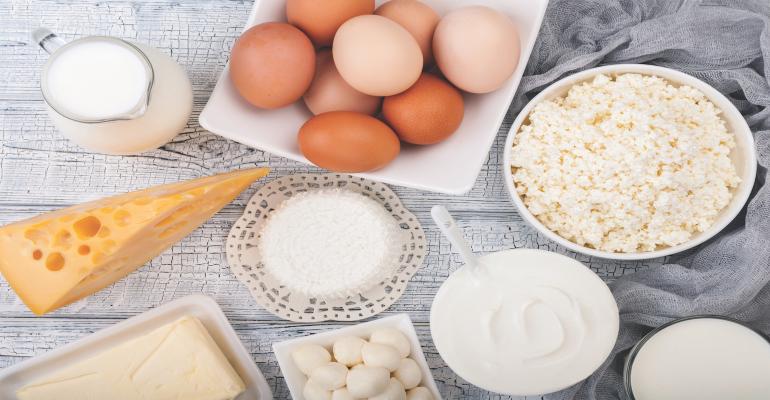The dairy category is facing some challenges in 2024, with holdover issues that began in 2023.
At the end of last year, dairy dollar sales at the supermarket decreased by 5.1%, according to figures released by the International Dairy Deli Bakery Association (IDDBA).
“As deflation arrived, the year-on-year dollar performance is vastly different from what we saw throughout 2022 and the first half of 2023,” said Whitney Atkins, vice president of marketing for IDDBA.
The IDDBA released a report by Mike McCully of McCauley Consulting in early 2024 that revealed that milk production has shrunk in the U.S., as well as in Europe and New Zealand, in recent months.
However, demand has also been weak.
In the latter months of the year, milk production was .6% lower than the same time last year, which was worse than expected. This can be attributed to the U.S. dairy herd decreasing by nearly 10,000 head in 2023. Still, McCully said that milk production in the U.S. is expected to increase in the year ahead by approximately 1%.
The report also showed that butter prices hit a historic high of $3.50 in October before dropping to a more reasonable $2.50 at supermarkets in the states. McCully said the outlook for 2024 is steady prices until there is a material shift in either supply or demand within the category.
“The overall dairy demand outlook remains modest with weak global demand, but good domestic, generally for cheese and butter,” he said.
Chris Mentzer, director of operations for Rastelli Market Fresh, a supermarket with locations in Marlton and Deptford, N.J., said that regardless of what issues the category is facing, dairy is a core category for any shopper, and items like milk, butter, eggs, yogurt, and cheese will always be on most people’s shopping lists.
Up and down
Supermarkets have been having different experiences with dairy, some good, some bad.
“Over the last year, we have seen an increase in sales for indulgent flavors of yogurt, items that customers are eating as a dessert instead of just a snack,” said Maria Brous, director of communications for Lakeland, Fla.-based Publix Supermarkets. “Also, milk and milk alternatives have seen growth.”
One dairy item selling strong is cottage cheese, which increased more than 12% year over year, with a big jump to 15.4% in the final two months of 2023, according to IDDBA. Those numbers are projected to remain solid in 2024.
The increase can be attributed to trending on social media platforms, according to Savannah Williams, client insight analyst for Circana.
Conversely, the biggest decline was in the egg category, which fell 31.5% in 2023. No one is quite sure what to expect in the year ahead after a year which saw decreases in production and increases in cost.
“The sales pattern in eggs are going to be a wild ride for a while to come,” said Jonna Parker, principal of fresh foods at Circana.
Other dairy items that have been on somewhat of an upswing in recent months are butter, natural cheese, and yogurt, though most experts believe numbers will fall somewhere between the strong beginning of 2023 and what the last half of the year brought.
Even with dairy sales looking somewhat lukewarm, the dairy segment remains the largest sales category in U.S. grocery stores at over $78 billion. Per-capita consumption of all dairy products reached 653 pounds per person in the U.S. in 2022, a whopping 21% higher than the historical average dating back to 1975, according to IDDBA.
Say cheese
The Dairy Farmers of Wisconsin’s annual report projected big things ahead for the cheese industry, something it has been seeing since 2022 when cheese consumption averaged 41 pounds per person in the U.S. and dropped slightly last year.
For 2024, the group expects to see innovation play a big role in keeping the numbers high, identifying five trends that will help that happen — cultivating connection, at-home culinary haven, mindful indulgence, a constant eye on global health, and flavor frenzy.
Alternatives invade ‘dairy’ case
Mike Saccoccia, director of procurement for Dave’s Marketplace, a Warwick, R.I.-based independent chain with 10 stores across Rhode Island, said alternative milks, including nut-based and oat-based options, continue to dominate the landscape in the dairy case, with prevalence leaning towards smaller sizes.
“It seems more families are choosing individual milks and milk alternatives versus a half gallon or gallon for a family,” he said. “Seems every family member wants to choose which fat or flavor they want. We are seeing many shopping carts with different alternative options and full fat or dairy options included. We are seeing more trends to the inclusion of DHA in organic options for improved neuro health.”
Dave’s Marketplace has also seen an uptick in organic milks in an effort to have less hormones in diets, particularly young children.
Mentzer said that while plant-based and vegan options are still popular in the department, inflation has cut down on some sales as the prices for these items are higher than conventional milk.
Kyle Kirkpatrick, director of center store for dairy for the Carlisle, Pa.-based The Giant Company, the operator of Ahold Delhaize USA’s Giant/Martin’s supermarkets, said while there continues to be innovation from a myriad of different plant-based sources, oat continues to make the largest noise in the alt-dairy category.
At Rastelli Market Fresh, the key to upping the basket with dairy items is to offer sales and specials. For instance, the store commonly offers discounts such as four yogurts for $5 or two half-gallon milks for $6.
“Offering off-brand items at lower prices has also been an effective strategy,” Mentzer said.





